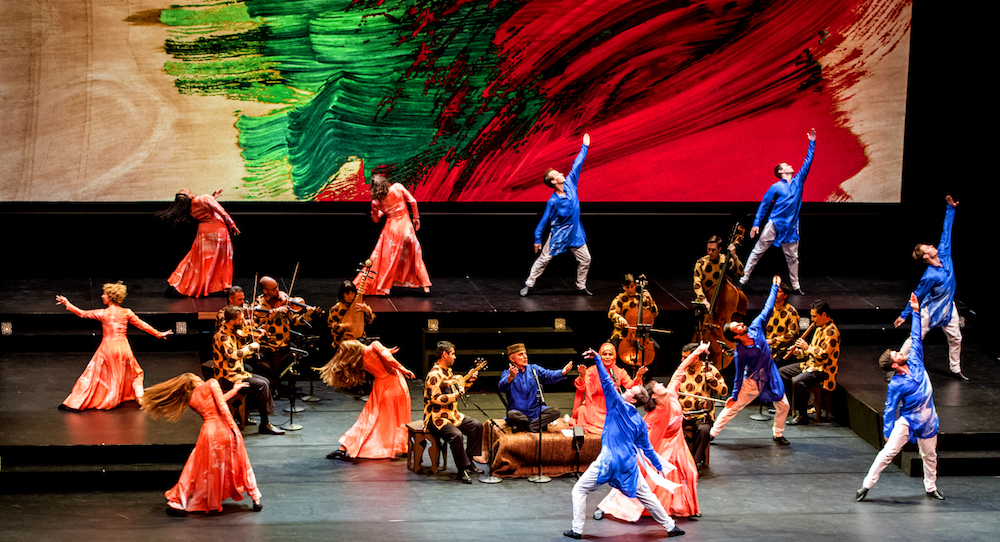Arts Centre Melbourne, Melbourne.
10 October 2018.
One of the core challenges for scribes tasked with “doing reviews” for the edification of complete strangers is to get beyond I liked/didn’t like. Layla and Majnun is a perfect example. Although I found it somewhat flat and dry on the night, it was abundantly clear why director/choreographer Mark Morris made the choices he made. Indeed, conceptually, the work is tight and consistent and, via the overarching tragedy of the lovers’ inevitable demise, points at one of our species’ age old dilemmas.

Mark Morris’ ‘Layla and Majnun’. Photo by Beowulf Sheehan.
Inspired by a seventh century legend and a 1908 Azerbaijani opera, Layla and Majnun is the classic doomed love story. Indeed, it pre-dates The Bard’s Romeo and Juliet by about 900 years. As such, our couple fall in love, get torn asunder by parents and other societal factors, and then eventually choose death over life apart. Complete with richly textural live music and sumptuous costuming, it should have been a heart-rending journey of passion, defiance and sacrifice; except that the performances lacked energy, and at times Morris’ grand vision appeared to stutter and lose focus.
This is a shame because it is clear to see what a remarkable confluence of cultures and talented individuals Layla and Majnun is. While the revered Silk Road Ensemble play and renowned mugham singers Alim Qasimov and his daughter Fargana provide the poetic vocals, the dancers weave in and around them, and we get sounds and movement motifs culled from sources like Arabia, Central Asia, India, the Caucasus and Slavic Europe.

Mark Morris’ ‘Layla and Majnun’. Photo by Mat Hayward.
Pulling all the disparate strands together, American dance and theatre maker Morris has nimbly executed a choreographic narrative that encapsulates the frustrated desire of the fated heroes and the orthodoxies of the strict honour culture that governed their lives. With discipline and conceptual rigour, he roots the dance grammar in the formalities of folk, court and classical traditions. The dancers rarely touch, and the movement palette is more sculptural than sensual. Indeed, there are echoes of Ancient Greek choruses, and Sufi asceticism in the modestly dressed, socially vetted actions of the lovers and the ensemble around them.
It’s here that the undoubted qualities, cleverness and bold emotional statement of Layla and Majnun are most apparent (in spite of my being generally underwhelmed). Morris’ tightly constrained choreography slowly unpeels the real tragedy; for, even in extreme circumstances, the lovers have no private expression and are restricted to the repetition of culturally mandated forms. In a world that consistently denies them, forcing them into narrow channels of experience and rendering them little more than ciphers of honour or mere breeding stock, the only possible valve of genuinely individual truth and action is death. In this, we see romantic love as a revolutionary act, with the lovers’ passion bursting out of the command and control perimeters of social class and custom and, finally, transcending into a form of apotheosis in death.

Mark Morris’ ‘Layla and Majnun’. Photo by Mat Hayward.
Thus, although Layla and Majnun was, on the night, disjointed and low on energy (and indeed some of the dancers lost their form and focus), it is clear that my lukewarm response is far from the whole story. The careful crafting and weaving of elements (opera, live music, dance) do indeed work together to create a conceptually unified and thematically solid hour of dance theatre. However, it is perhaps only fair to note that in spite of the beauty of the Silk Road Ensemble’s playing and the haunting breathy vocals of Alim and Fargana, the piece lacked the crushing heartbreak and cathartic drama that the legend of our doomed seventh century lovers promises.
By Paul Ransom of Dance Informa.

















